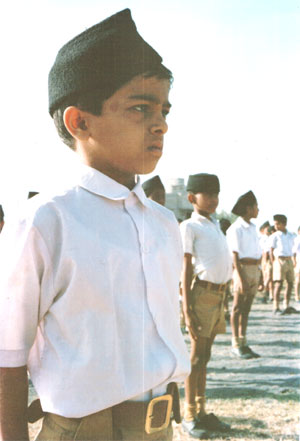|
|
 |
|
|
In early 1993, Lalit Vachani and the Wide Eye Film team completed
a documentary film, The Boy in the Branch, for Channel 4 Television,
U.K. Set at the headquarters of the RSS in Nagpur, the film was
about the indoctrination of young Hindu boys by a branch of the
RSS, the foremost Hindu fundamentalist organization in India. Eight
years later, Vachani returned to Nagpur to meet the characters from
his earlier film.
We had entered RSS territory expecting to confirm our received images of fascism. Instead, what we found was far more ingenious and unsettling in its simplicity: the lure of a playground where young boys played games and the hopes and dreams, fears and anxieties of ordinary young people as the banal face of fundamentalism. On December 6th, 1992, 45 days after the shoot when the film was near completion, members of the RSS and its affiliates destroyed the Babri mosque at Ayodhya. Where were Lalit, Kali, Sripad, and Sandeep when the mosque was razed to the ground? What did they think about the deaths of at least 1500 people (mostly Muslim) in the riots that followed the demolition? What had happened to them since that time, as the RSS and Hindu nationalism moved from the margins to the center of Indian politics, from an oppositional movement to the ideology of the government presently in power? Eight years later, we returned to Nagpur in search of Kali, Sandeep, Sripad and Lalit. Combining the conventions of the political documentary and the personal 'revisit', The Men in the Tree is a documentary in four parts: Part I, Memories (22 min.) is a personal reflection on the making of the earlier film, The Boy in the Branch. Part II, Buildings (24 min.) builds on the characters of The Boy in the Branch, in that we meet Sandeep, Sripad and Kali in the present, after a gap of eight years. However, it is primarily about the making and the breaking of various buildings, the most prominent one being the Babri mosque, destroyed in December 1992. Part III, Stories (32 min.) is the talking heads/information section of the film. It is about the kind of stories that circulate within the RSS branch and broader RSS culture and the attempts by RSS ideologues to rewrite and Hinduize a secular Indian history. Former RSS volunteers, D.R. Goyal and Purshottam Agarwal provide an internal critique and a framework to understand the ambivalence of the RSS to national leaders like Mahatma Gandhi and contextualize the RSS hostility towards Muslim and Christian minorities in India. Part IV, Branches (20 min.) is about the state of RSS branches in contemporary India in the form of a return to the branches that the team filmed in 1992. The film ends with an epilogue concerning the
events of March 2002. At the time, The Men in the Tree was almost
complete. The RSS affiliate, the VHP launched a new agitation to
build the Ram temple at Ayodhya. This resulted in the horrifying
genocide in Gujarat, where estimates suggest that over two thousand
Muslims were killed by members of the Hindu right. Camera : Ranjan Palit |
Screening and Discussion
with filmaker Lalit Vachani
Friday,
December 6th
7:30 - 9:30 PM
University of California, Berkeley
Graduate School of Journalism
105 North Gate Hall
directions
FREE AND OPEN
TO THE PUBLIC
Co-sponsored by
UCB Center for South Asian Studies;
Dept. of Cultural & Social Anthropology; California Institute of Integral
Studies; Coalition
Against Communalism (CAC); and Friends
of South Asia (FOSA).
Saturday,
December 7th
6 - 8:00 PM
Stanford University
Room 002, Bldg 200;
History Corner, 450 Serra Mall
directions
FREE AND OPEN TO THE PUBLIC
Co-sponsored
by the
Dept. of Cultural & Social Anthropology and Dept. of Religious Studies,
Stanford U.;
Dept. of Cultural & Social Anthropology, California Institute of Integral
Studies; and Friends
of South Asia (FOSA).
Recent
Press Articles
Exposing
Problems in India
Daily Pennsylvanian
"Breeding
little fascists"
Frontline
 THE
MEN
THE
MEN  In
October 1992, Lalit Vachani and the Wide Eye Film team were filming
The Boy in the Branch. At the time, Kali, the central character
of the film, was nine years old. He had joined the RSS branch because
it was a fun place where children could play games after school
every day. Sandeep, twenty-one years old, spoke about his devotion
to the Hindu nationalist cause, and how he would spend his life
serving the RSS. Sripad, an RSS martial arts expert (nineteen at
the time) was passionate about building his own body and building
the Hindu nation. And Lalit, age eighteen, was a gentle, atypical
volunteer who disliked the physical program of the RSS, even though
he was assigned to train the younger boys in Karate.
In
October 1992, Lalit Vachani and the Wide Eye Film team were filming
The Boy in the Branch. At the time, Kali, the central character
of the film, was nine years old. He had joined the RSS branch because
it was a fun place where children could play games after school
every day. Sandeep, twenty-one years old, spoke about his devotion
to the Hindu nationalist cause, and how he would spend his life
serving the RSS. Sripad, an RSS martial arts expert (nineteen at
the time) was passionate about building his own body and building
the Hindu nation. And Lalit, age eighteen, was a gentle, atypical
volunteer who disliked the physical program of the RSS, even though
he was assigned to train the younger boys in Karate.